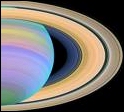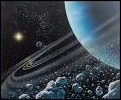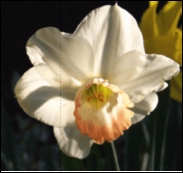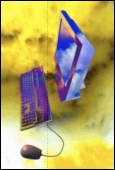Guest Astrologer
Donna Cunningham
NeptuneCafe presents
Part Two
in a series
about Saturn
and Uranus
advertisements
Saturn-Uranus Aspects
Understanding the conjunction
She has a Master’s degree in Social Work from Columbia University and over 40 years of experience in working with people. Her ebooks can be found at Moon Maven Publications Visit her blog at skywriter.wordpress.com.
About the Author: Donna Cunningham is an internationally-respected author of books, articles, and columns about astrology, flower essences and other metaphysical topics. Her insights reflect her dual background in astrology and psychotherapy.
The material on this page is excerpted with permission from Donna Cunningham's eBook, titled
Aspects between the Outer Planets: The Outer Planets and Inner Life, v.3
For more information on this and several other of her eBooks, visit www.moonmavenpublications.com
questions, comments? email wolfstar@neptunecafe.com
Coming soon in Part 3 -
Continued discussion of the aspects, featuring the square, trine and oppostion, plus Saturn-Uranus apsects in maturity
Don't miss: A Curious Case of Date Twins -
Two astrologers with the Square
Some Life Patterns of Uranus-Saturn People
“Silly things cease to be silly if they are done by sensible people in an impudent way.”
Jane Austen, Emma
Those born with this combination will likely be going through a tough balancing act, as they take the brunt of the changes inferred by this challenging Saturn-Uranus dynamic. Here's a look at the conjunction. If you missed Part One of this series, you can find it here
Worried about the Cardinal T-square of Pluto, Saturn, and Uranus?
See a huge collection of useful articles on how to handle those transits by over 50 talented astrologers.
The International Astrology Day Blogathon
will help you sort it out at:
of friends express astonishment or skepticism about my career path. Because I answer their questions calmly and intelligently, they often go away saying, “I never thought there was anything to this stuff, but she’s no flake. Maybe I’ll give it a try.” I generally refer to myself as a sane weirdo.
Capable astrologers or alternative health practitioners with academic credentials often serve a similar function by demonstrating the worth of their techniques to psychotherapists or medical personnel through cases they hold in common. I was one of the earlier people to do so, with my master’s degree in social work, and it’s been a joy to see a growing number of people in our field with therapeutic qualifications. Others of our number blend astrology with academic pursuits like philosophy or history. Kepler College was founded as an academic environment in which astrology was consistently blended into liberal arts studies. The combination of Saturn and Uranus in a chart, especially paired with Mercury, Jupiter or the 3rd-9th house axis, can represent a scholarly individual, and these placements are featured in the charts of the classy intellectuals in our field like Rob Hand and Caroline Casey.
Another pattern is what might be called grown-ups with erector set mentalities. Natives with these aspects can painstakingly build elaborate structures for their lives only to tear them down again some years later and start fresh projects in search of excitement and mental stimulation. Saturn needs structure, stability, and a sense of accomplishment, while Uranus detests stagnation and chafes at any constriction to its freedom.
The house placements of Saturn and Uranus or of Capricorn and Aquarius show what areas of life this pattern touches. People who have one or both planets in the vocational houses (2nd, 6th, or 10th) or aspecting the Midheaven may work very hard to establish a career or business and, because of their many gifts and capabilities, may enjoy an enviable success. Over the course of a lifetime, there are likely to be several dramatic shifts in career direction as they become so bored and restless that they start over from scratch.
I generally begin exploring aspects between the outermost planets—Saturn to Pluto—by researching the eras in which they occurred. These slow-moving aspects generally herald dramatic historical events and powerful social and economic developments that create a pervasive emotional climate and cast long shadows. That climate can be nearly as influential as family dynamics in shaping the individual, especially when a family is directly touched by historic events.
However, in the case of Uranus-Saturn aspects, that approach isn’t especially fruitful because over the past century, there were few instances of stand-alone aspects between these two planets. For the most part, they coincided with important aspects to Neptune or Pluto, so it’s difficult to separate out the individual planetary influences.
For instance, in 1930-32, as the Great Depression settled in, Saturn in Capricorn was square Uranus in Aries, but together they formed a t-square with Pluto in Cancer, a combination that testifies to the hardships of that time.
At the height of World War II, in parts of 1941-43, Saturn and Uranus were conjunct but trine Neptune. In all but a few months of 1951-2, Saturn in Libra was square Uranus in Cancer but also conjunct Neptune. At the peak of the 1960s’ social unrest, from 1965-67, Saturn in Pisces was opposite both Pluto and Uranus. In the late 1980s, Saturn in Capricorn was simultaneously conjunct Uranus and Neptune.
The table above gives years in which these aspects were intermittently in range, though you’d have to consult the individual chart to see whether they applied or not. My orbs are 8-10̊ for a conjunction or opposition, 5-6̊ for a square or trine. Of the hard aspects listed above, I’d see the conjunction of 1941-43 trined by Neptune as least contaminated by other influences because the conjunction is a powerful union of two energies, and the trine from Neptune doesn’t force a choice between Uranus and Saturn in the way that a square or opposition would do. Let’s look at some examples of that one.
The Conjunction: In any conjunction, the energies of the two planets almost become one, in the same sense that copper and zinc together become brass, an alloy that doesn’t exist independently. Likewise, people with conjunctions have no choice but to develop strategies for the pair to coexist peacefully. As life unfolds, they can no longer envision those energies as separate or imagine any other way of operating.
People who lived with the Uranus-Saturn conjunction of 1941-43 over time were forced to develop unique solutions to the contradictions they experience within themselves and in the world around them. That’s why they might just be among the most valuable marginal individuals in times of extreme change like ours. Many of them were on the front lines of various types of demonstrations during the 1960s, and we might expect a renewed albeit more mature and level-headed activism from them during the transiting opposition of Uranus and Saturn of 2008-10.
What’s interesting—and instructive—about that conjunction is that, because of retrograde motion, Uranus and Saturn both crossed back and forth over the Taurus-Gemini cusp during parts of 1941-42. Since the period began with Uranus and Saturn in Taurus and ended with them in Gemini, we can get a sense of how this aspect operates in two distinct signs and elements. Previously, I’ve written abut the difference between “air smart” and “earth smart.” An air smart individual may have a million bright ideas in the course of a lifetime and yet lack the skill or inclination to put many of them into practice. An earth smart individual may have only one or two bright ideas in the course of a lifetime but may develop the practical applications of that idea thoroughly enough to earn a comfortable living.
Taurus is a fixed earth sign, so many with Uranus placed there are inventive yet extremely practical in applying their brilliance. Before adopting a new idea or technology, they need a demonstration that a new idea or product works reliably and that it can positively affect the bottom line. Taurus is fairly conservative by nature, while Uranus—the ruler of Aquarius—is modernistic and even radical at heart. This somewhat uneasy combination has produced some very down to earth yet far-thinking people with an eye to the ecological implications of modern technology. Uranus in Taurus natives would be apt to embrace the recycling movement.
Interval:
45-48 years between repetitions of the same type of aspect, e.g., between two opening squares.
Conjunct:
---------------
1941-43
1987-89
Square:
-------------
1908-10
1930-32
1951-52
1975-77
1999-2000
Opposite:
--------------
1917-1920
1964-67
2007-10
Saturn-Uranus Aspects & When They occurred:
One quality I often observe in people with Uranus-Saturn aspects is the pairing of off-beat ideas and interests with sound ways of expressing and applying them—a combination that enhances a marginal individual’s ability to serve as a bridge between two distinct subcultures. Although I’ve long since gotten past the need to prove astrological or metaphysical principles to the uninitiated, I’m occasionally in social situations where friends
If the Moon, the IC, or 4th house planets are aspected by this pair, we can see people with a touch of gypsy in their soul who make major relocations every few years. If the 7th house is involved, these folks might have a series of unconventional committed relationships that work for a respectable length of time but ultimately end. Major life departures like those above tend to occur under
Uranus transits or transits that set off the natal Uranus-Saturn aspect.
Understanding Individual
Uranus-Saturn Aspects
Two Examples of the Conjunction: Let’s look at contrasting ways two people with the conjunction—one in earth and the other in air—use its potentials. The first is Lynne, my personal assistant and long-time friend who was born with Uranus, Saturn, and Mars conjunct the Ascendant in Taurus and trining the Moon and Neptune in Virgo. She’s richly gifted with practical skills. At home, she’s a master gardener, gourmet chef, brilliant money manager, all-round Ms. Fixit for home improvements, and actually understands the mysterious inner workings of an automobile.
Uranus is very different in Gemini, a mutable air sign with a flair for communication and popularization. Uranus rules computers and other technological advances, and typical gadget-loving Uranus in Gemini folks are at home with computers, cell phones, the internet, and other forms of instant communication and information processing. They are perennially curious, trendy, and keen to find out what’s new. (Some
people born during this era had a mixture of Taurus and Gemini placements, making the merger between the two planets more challenging to create and sustain.)
writing, takes high quality digital photos like this narcissus for my website, and organizes the scattered files on my hard drive. Lynne can do anything, and, with no more than a wisp of earth in my own chart, I’m perpetually in awe of her abilities.
I’m equally in awe of astrology’s Rob Hand, who’s just as gifted as Lynne but with a more cerebral array of skills and a more academic and arcane focus. (I don’t know if Rob is able to FIX anything other than computer glitches—say a closet door that’s off its track or a leaky faucet—but, frankly, it would be a comfort to me if he couldn’t!) His chart features the Uranus-Saturn conjunction in Gemini straddling the 11th-12th house cusps, with Saturn (the 12th house planet) opposing his Sun and Mercury in Sagittarius in the 6th. Uranus rules his 9th, the house of higher education.
In the 1970s, he was the first to write astrology programs, paving the way for decades of rapid progress in software that streamlines astrology practice and opens the door to undreamed-of possibilities in research. (Other astrologers with Uranus-Saturn aspects who made important contributions to the development of astrological software are Jim Lewis and Michael Erlewine with the conjunction and Mark Pottenger with the trine.)
Like many Uranians, Rob seems to perennially reinvent himself, and so he has used many different branches of astrology in his work. His focus since the 1990s is on ancient and medieval techniques, working with others to translate the original documents. (One of his finest gifts is that of gathering around himself a brain trust to collectively explore advanced applications of our field.)
For more details see the interview in the August/September, 2008 issue of The Mountain Astrologer. In that article he is quoted as saying, “I want to be remembered as someone who helped to reconnect the future of astrology with its past.” Is that not the very essence of a Uranus-Saturn conjunction?
In my office, Lynne’s official job description is, “Make it stop doing that!” She makes my computer software and hardware behave themselves and does small repairs in the office itself. She creates data bases, helps me shop for the best deals on equipment and gets it up and running, critiques my







